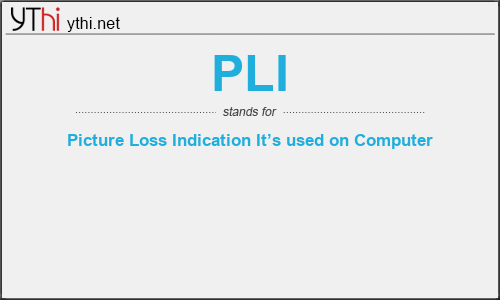What does PLI mean? What is the full form of PLI?
1, The full form of FIR is Picture Loss Indication. It’s used on Computer
PLI stands for Picture Loss Indication. It is one of the error resiliency mechanisms in WebRTC.
A PLI can be sent when the receiver of the media lost a full frame or more. It is sent over RTCP.
A receiver of this message can decide to resent a full frame if he has one available in cache and finds it usable.
This message is similar to a FIR message but a bit more lenient in its heuristic.
Picture Loss Indication (PLI)
The PLI FB message is identified by PT=PSFB and FMT=1.
There MUST be exactly one PLI contained in the FCI field.
6.3.1.1. Semantics
With the Picture Loss Indication message, a decoder informs the
encoder about the loss of an undefined amount of coded video data
belonging to one or more pictures. When used in conjunction with any
video coding scheme that is based on inter-picture prediction, an
encoder that receives a PLI becomes aware that the prediction chain
may be broken. The sender MAY react to a PLI by transmitting an
intra-picture to achieve resynchronization (making this message
effectively similar to the FIR message as defined in [6]); however,
the sender MUST consider congestion control as outlined in Section 7,
which MAY restrict its ability to send an intra frame.
Other RTP payload specifications such as RFC 2032 [6] already define
a feedback mechanism for some for certain codecs. An application
supporting both schemes MUST use the feedback mechanism defined in
this specification when sending feedback. For backward compatibility
reasons, such an application SHOULD also be capable to receive and
react to the feedback scheme defined in the respective RTP payload
format, if this is required by that payload format.
Format
The Slice Loss Indication uses one additional FCI field, the content
of which is depicted in Figure 6. The length of the FB message MUST
be set to 2+n, with n being the number of SLIs contained in the FCI
field.
0 1 2 3
0 1 2 3 4 5 6 7 8 9 0 1 2 3 4 5 6 7 8 9 0 1 2 3 4 5 6 7 8 9 0 1
+-+-+-+-+-+-+-+-+-+-+-+-+-+-+-+-+-+-+-+-+-+-+-+-+-+-+-+-+-+-+-+-+
| First | Number | PictureID |
+-+-+-+-+-+-+-+-+-+-+-+-+-+-+-+-+-+-+-+-+-+-+-+-+-+-+-+-+-+-+-+-+
Figure 6: Syntax of the Slice Loss Indication (SLI)
First: 13 bits
The macroblock (MB) address of the first lost macroblock. The MB
numbering is done such that the macroblock in the upper left
corner of the picture is considered macroblock number 1 and the
number for each macroblock increases from left to right and then
from top to bottom in raster-scan order (such that if there is a
total of N macroblocks in a picture, the bottom right macroblock
is considered macroblock number N).
Number: 13 bits
The number of lost macroblocks, in scan order as discussed above.
PictureID: 6 bits
The six least significant bits of the codec-specific identifier
that is used to reference the picture in which the loss of the
macroblock(s) has occurred. For many video codecs, the PictureID
is identical to the Temporal Reference.
The applicability of this FB message is limited to a small set of
video codecs; therefore, no explicit payload type information is
provided.

2, The full form of FIR is Prime Lending Institutions
PrimeLending, A PlainsCapital Company’s loan servicing
PLI
means
Picture Loss Indication It’s used on Computer![]()
Translate Picture Loss Indication It’s used on Computer to other language.


Leave a Reply
You must be logged in to post a comment.